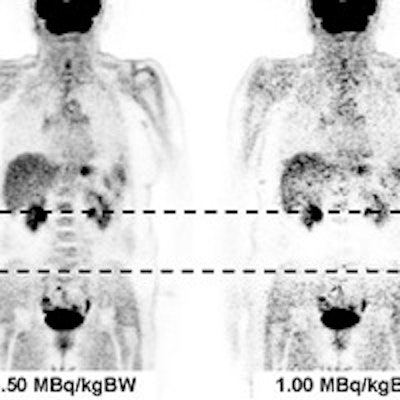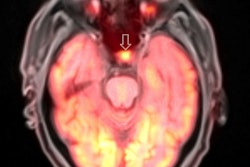
Even though a lower dose of FDG did not significantly affect lesion detection for most adult cancer patients undergoing a whole-body PET/MRI scan, German researchers recommend that clinicians stay with recommended levels to avoid artifacts, according to a study published in the Journal of Nuclear Medicine.
The researchers found that FDG dose could go as low as 2 MBq/kg based on body weight (BW) with no significant degradation in diagnostic image quality in most middle body areas. However, FDG doses below the standard level of 3 MBq/kgBW also resulted in large artifacts in the abdominal/pelvic region (JNM, March 30, 2017).
"The occurrence of this artifact cannot currently be predicted and the clinical impact is unclear," wrote lead author Dr. Ferdinand Seith from Eberhard Karls University Tübingen and colleagues. "Therefore, we do not recommend reducing doses below 3 MBq/kgBW in oncologic PET/MRI examinations in adults at this time."
PET/MRI combination
PET has been the modality of choice for oncology applications for many years, with FDG as the most widely used tracer to delineate the characteristics of many tumor types. With FDG dose administration guidelines based primarily on phantom studies, the researchers described the need to establish more dependable parameters to definitively reduce dose for the safety of patients and clinicians, while simultaneously maintaining diagnostic image quality.
"Due to the high sensitivity of PET detectors in current PET/MRI scanners and commonly longer PET acquisition times compared to PET/CT, a reduction of PET tracer doses might be feasible for PET/MRI examinations," they proposed.
Prospective studies of the effects of different FDG amounts on patients are considered "ethically not feasible"; therefore, Seith and colleagues used a new approach that simulates tracer dose reduction on whole-body scans using randomized PET data.
Through this process, the researchers retrospectively calculated FDG dose at various PET image acquisition times based on incremental amounts of 0.25 MBq/kgBW of FDG. They began at 0.5 MBq/kgBW of FDG and worked their way up to the recommended standard of 3 MBq/kgBW of FDG.
"The technique has made it possible to retrospectively simulate PET examinations of several lower doses of one patient by randomly deleting proportions of PET events over the acquisition time," they explained.
Patient evaluations
For the study, the researchers examined 19 patients with a mean age of 50.9 years (± 11.7 years) and body mass index (BMI) of 22.8 (± 3.2). The subjects underwent simultaneous torso PET/MRI scans (Biograph mMR, Siemens Healthineers) between October 2012 and July 2014.
The patients received an injected FDG dose of at least 3 MBq/kgBW, and acquisition scan time per bed position was four to six minutes. Most of the patients were evaluated for breast cancer (seven cases), with the next most common reason being bronchial carcinoma (three patients).
To assess the reliability of the retrospective tracer uptake analysis, the researchers recorded mean standardized uptake values (SUVmean), adjusted for body weight, in eight regions of the torso. PET/MRI results were read by a radiologist and a nuclear medicine physician with experience in hybrid imaging. The pair sought to determine the effects of a reduced FDG dose versus conventional amounts for lesion detection, evaluating lesions for a variety of cancers.
In all, 90 lesions were found and characterized using the standard maximum dose of 3 MBq/kgBW. Of that total, PET images with 2 MBq/kgBW of FDG correctly identified 86 lesions (95%). In addition, there were no false-negative or false-positive results.
With the simulated dose of 2 MBq/kgBW, the subjective image impression as well as the diagnostic performance of oncologic reading did not differ substantially when compared with higher doses in most cases. Diagnostic confidence also remained steady with most dose amounts.
 FDG-PET images show good image quality in a 43-year-old patient with a dose of 1 MBq/kgBW (A). However, there was an artifact in the abdominal region (B) at lower doses. This region was located completely within one bed position (dotted line). Images courtesy of JNM.
FDG-PET images show good image quality in a 43-year-old patient with a dose of 1 MBq/kgBW (A). However, there was an artifact in the abdominal region (B) at lower doses. This region was located completely within one bed position (dotted line). Images courtesy of JNM.Interestingly, the readers considered most PET images with FDG doses of 1.25 to 2.75 MBq/kgBW to be just as good as those with 2 MBq/kgBW. One PET image with 2.75 MBq/kgBW and nine PET images with 3 MBq/kgBW were rated as substantially better.
Still, the researchers encountered artifacts in PET images of the urinary bladder in three patients, as well as large photopenic areas in the middle abdomen in two different patients.
Lower FDG dose amounts adversely affected SUVmean values for the small bowel, psoas muscle, and lumbar vertebra, all of which are part of the abdominal-pelvic region. As FDG dosage declined, so did the SUVmean and the ability to detect and diagnose lesions in this area.
Seith and colleagues suggested a workaround to reduce artifacts in the abdominal region by repositioning the PET fields-of-view, and extended acquisition times might compensate for the lower doses of FDG. They added that further study is needed to validate this suggestion, however.
Lowering FDG doses to 2 MBq/kgBW "might be possible in whole-body PET/MRI examinations of oncologic patients with no distinct effect on lesion detection, diagnostic confidence, or a study evaluation according to [PET Response Criteria in Solid Tumors (PERCIST)]," the authors concluded. "However, the impact of reducing doses on image quality and SUV measurements is highly dependent on body regions, mostly affecting the middle abdomen."




















